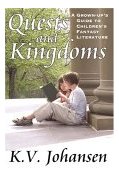Quests and Kingdoms: A Grown-Up's Guide to Children's Fantasy Literature

by K. V. Johansen
464 pages,
ISBN: 0968802443
Post Your Opinion | | Kids' Lit
by OR Melling
Teachers and booksellers will both concur that fantasy is no longer genre fiction but mainstream reading for the young . How timely, then, is this "tour through the history of fantasy for children" written by a research fellow in Children's Literature at the University of New Brunswick and a children's writer herself (her Torrie and the Pirate-Queen was nominated for this year's Silver Birch).
Despite the contribution of classics such as Alice in Wonderland, Gulliver's Travels, and Peter Pan, fantasy has long battled entrenched prejudice in literary and critical circles. Johansen grasps the nettle immediately with an introduction which asks "Why Fantasy? (And what is it anyway)?" Having set her own limits on a branch of writing that can range from myth and fairy tale to time travel and talking animals, she asserts its literary as well as socio-psychological value. Bolstered by arguments from JRR Tolkien and CS Lewis, she points out wryly that the earliest known piece of literature, the Sumerian tale of Gilgamesh, as well as the first piece of English literature, Beowulf, would both be classified as fantasy today. And in a nice twist, she remarks that contemporary "literary fiction" is as much a genre as any other.
With chapters arranged chronologically, individual sections are headed by author name and include personal histories, bibliographies, critical comment, and detailed plot synopses. The latter is intended to introduce the books to librarians, teachers, parents, and other interested adults. You can dip and browse at will or read from front to back, for this is not only a fine reference tool but a finely-written book.
Ninety-five authors and over five hundred books are sited, beginning with Madame d'Aulnoy (1650-1705), whose Contes des fTes first retold and disseminated now ubiquitous tales such as "Beauty and the Beast". The magical labyrinth winds through the likes of the Grimms Brothers and Hans Christian Andersen, past the wonders of E. Nesbit, Kenneth Grahame, and L. Frank Baum's The Wizard of Oz, and on to Hugh Lofting's Dr Doolittle and the delights of Beatrix Potter. But such short shrift for PL Travers, the creator of Mary Poppins! Barely a few paragraphs and no mention of her friendship with Yeats or her time amongst the Navajo which led to her being a founding editor of Parabola, the prestigious American journal of myth and folklore.
As the father of modern fantasy, JRR Tolkien is given his own chapter and rightfully so. However, I could only snort at the notion that his illustrations and poetry are of any note outside of his great epic The Lord of the Rings. But therein lies another strength of Johansen's work. It promises to elicit lively reactions not only because of its content-books and authors loved since childhood-but also its presentation. As with all the best non-fiction, it is written with passion and opinion.
The 1950s introduces authors such as Mary Norton, Philippa Pearce of Tom's Midnight Garden, and Rosemary Sutcliff (1920-1992), "who must be numbered among the great children's writers of the twentieth century." A chapter on "Eternal Heroes-King Arthur and Robin Hood" includes T.H. White's The Once and Future King and Mary Stewart's Merlin trilogy. The 1960s sees such notables as Alan Garner, Madeleine l'Engle, and Lloyd Alexander while the 1970s has the likes of Ursula LeGuin, Patricia A McKillip, Diana Wynne-Jones, and Susan Cooper with her wondrous The Dark is Rising series. The 1980s brings the first Canadian entry with Charles de Lint, winner of the World Fantasy Award in 2004 (though this is not mentioned) and the 1990s sees the second Canadian, i.e. myself, along with the most illustrious writer of this era, Philip Pullman.
The chapter "Into the Twenty-First Century" begins with JK Rowling as a young author already influencing the decades ahead. Arguably Rowling ought to have her own chapter, like Tolkien, considering the unprecedented phenomenon of her publishing story. Overall, Johansen is critical of the Harry Potter books but she concludes that they will be recognized as classics "even after the current popular frenzy has ebbed." Immediately after Rowling comes the third and last Canadian, Kenneth Oppel, along with international best-sellers Neil Gaiman, Garth Nix, and Cornelia Funke. Surprisingly, American teen wonder Christopher Paolini of Eragon fame is not mentioned. However, it is clear that a successful fantasy in this century means world-wide sales of astounding proportions.
If international acclaim is not enough to persuade its detractors that fantasy is of worth, then surely the quantity and quality of the writers sited in this work will do so. It's inevitable for many fine authors, past and present, to have been omitted, and one can only hope that this first edition will be revised over time to include those left out, in particular such Canadians as Monica Hughes, Tim Wynne-Jones, and Karleen Bradford. This is undoubtedly a seminal work guaranteed to stimulate discussion on children's literature in general and children's fantasy literature in particular. ò
|